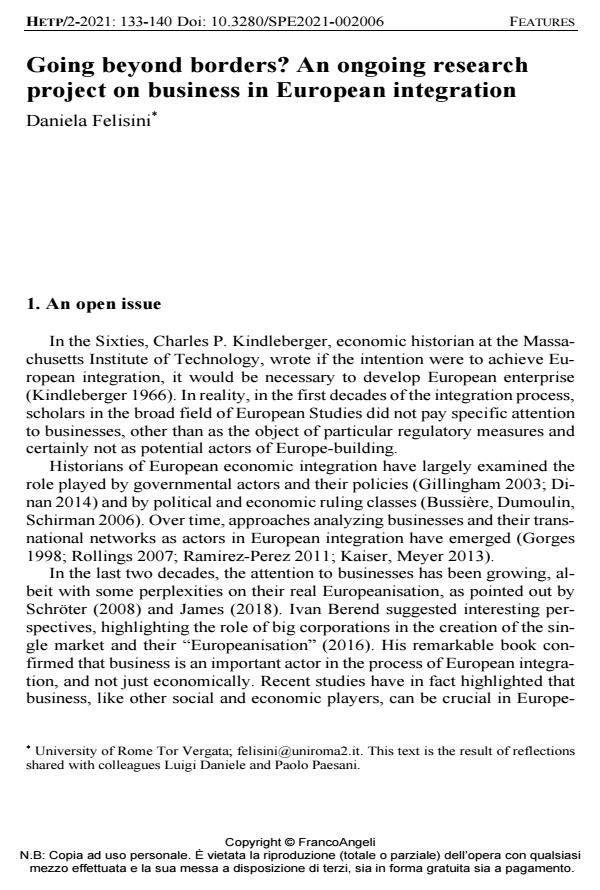Going beyond borders? An ongoing research project on business in European integration
Journal title HISTORY OF ECONOMIC THOUGHT AND POLICY
Author/s Daniela Felisini
Publishing Year 2022 Issue 2021/2
Language English Pages 8 P. 133-140 File size 34 KB
DOI 10.3280/SPE2021-002006
DOI is like a bar code for intellectual property: to have more infomation
click here
Below, you can see the article first page
If you want to buy this article in PDF format, you can do it, following the instructions to buy download credits

FrancoAngeli is member of Publishers International Linking Association, Inc (PILA), a not-for-profit association which run the CrossRef service enabling links to and from online scholarly content.
- Amatori F. (1999). European business: New strategies, old structures, Foreign Policy, 115, 78-89.
- Berend I.T. (2016). The History of European Integration. A New Perspective, Routledge, 2016.
- Bussière E., Dumoulin M. and Schirmann S. (eds.) (2006). Europe du libre-échange ou Europe des marchés dirigés - Fin XIX° siècle - années 1960, Actes du colloque de Metz 2003, Bruxelles, Peter Lang, Euroclio.
- Chandler A.D. Jr. (1990). Scale and Scope: The Dynamics of Industrial Capitalism, Cambridge, Cambridge University Press.
- Coen D., Dannreuther C. (2003). Differentiated Europeanization: Large and Small Firms in the EU Policy Process. In Featherstone K. and Radaelli C.M. (eds.), The Politics of Europeanization, Oxford, Oxford University Press.
- Gerber D.J. (1998). Law and Competition in Twentieth Century Europe: Protecting Prometheus, Oxford, Oxford University Press.
- Gillingham J. (2003). European Integration, 1950–2003. SuperState or New Market Economy?. Cambridge - New York, Cambridge University Press.
- Gorges M.J. (1996), Euro-corporatism? Interest intermediation in the European Community, Lanham, University Press of America.
- James H. (2018). Is Business European, or National? Paper presented at the Workshop “In Search of European Capitalism”, European University Institute, 15 - 16 March, mimeo.
- Kaiser W. and J.H. Meyer (eds.) (2013). Societal actors in European integration: from polity-building to transnational politics and policymaking, Basingstoke, Palgrave.
- Kindleberger C. (1966). European Integration and the International Corporation, Columbia Journal of World Business, 1 (1): 65–76.
- Landes D. S. (2003). The Unbound Prometheus: Technological Change and Industrial Development in Western Europe from 1750 to the Present, 2nd edition Cambridge, Cambridge University Press, 506–15.
- Patel K. K. (2015). The Making of Homo Europaeus: Problems, Approaches and Perspectives, Comparativ: Zeitschrift für Globalgeschichte und vergleichende Gesellschaftsforschung, 25, 19-37.
- Rollings N. (2007). British business in the formative years of European integration, 1945-1973. Series: Cambridge studies in the emergence of global enterprise. Cambridge - New York, Cambridge University Press.
- Rollings, N. and Warlouzet, L. (2020) Business History and European Integration: How EEC Competition Policy Affected Companies’ Strategies, Business History, 62(5), 717-742, https://doi.org/10.1080/00076791.2018.1488966.
- Schröter H.G. (1996). Cartelization and Decartelization in Europe, 1870–1995: Rise and Decline of an Economic Institution, Journal of European Economic History, 25/1, 129-153.
- Schröter H.G. (ed.) (2008). The European Enterprise. Historical investigation into a future species, Berlin, Heidelberg Springer.
Daniela Felisini, Going beyond borders? An ongoing research project on business in European integration in "HISTORY OF ECONOMIC THOUGHT AND POLICY" 2/2021, pp 133-140, DOI: 10.3280/SPE2021-002006